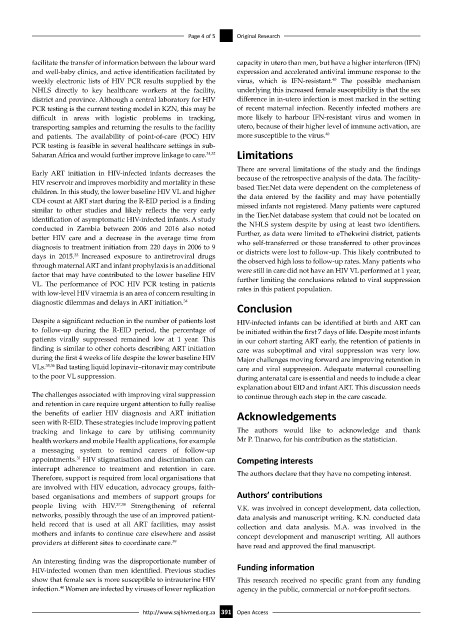Page 399 - HIVMED_v21_i1.indb
P. 399
Page 4 of 5 Original Research
facilitate the transfer of information between the labour ward capacity in utero than men, but have a higher interferon (IFN)
and well-baby clinics, and active identification facilitated by expression and accelerated antiviral immune response to the
40
weekly electronic lists of HIV PCR results supplied by the virus, which is IFN-resistant. The possible mechanism
NHLS directly to key healthcare workers at the facility, underlying this increased female susceptibility is that the sex
district and province. Although a central laboratory for HIV difference in in-utero infection is most marked in the setting
PCR testing is the current testing model in KZN, this may be of recent maternal infection. Recently infected mothers are
difficult in areas with logistic problems in tracking, more likely to harbour IFN-resistant virus and women in
transporting samples and returning the results to the facility utero, because of their higher level of immune activation, are
and patients. The availability of point-of-care (POC) HIV more susceptible to the virus. 40
PCR testing is feasible in several healthcare settings in sub-
Saharan Africa and would further improve linkage to care. 31,32 Limitations
There are several limitations of the study and the findings
Early ART initiation in HIV-infected infants decreases the
HIV reservoir and improves morbidity and mortality in these because of the retrospective analysis of the data. The facility-
children. In this study, the lower baseline HIV VL and higher based Tier.Net data were dependent on the completeness of
CD4 count at ART start during the R-EID period is a finding the data entered by the facility and may have potentially
similar to other studies and likely reflects the very early missed infants not registered. Many patients were captured
in the Tier.Net database system that could not be located on
identification of asymptomatic HIV-infected infants. A study the NHLS system despite by using at least two identifiers.
conducted in Zambia between 2006 and 2016 also noted Further, as data were limited to eThekwini district, patients
better HIV care and a decrease in the average time from who self-transferred or those transferred to other provinces
diagnosis to treatment initiation from 220 days in 2006 to 9
days in 2015. Increased exposure to antiretroviral drugs or districts were lost to follow-up. This likely contributed to
33
through maternal ART and infant prophylaxis is an additional the observed high loss to follow-up rates. Many patients who
factor that may have contributed to the lower baseline HIV were still in care did not have an HIV VL performed at 1 year,
VL. The performance of POC HIV PCR testing in patients further limiting the conclusions related to viral suppression
with low-level HIV viraemia is an area of concern resulting in rates in this patient population.
diagnostic dilemmas and delays in ART initiation. 34
Conclusion
Despite a significant reduction in the number of patients lost HIV-infected infants can be identified at birth and ART can
to follow-up during the R-EID period, the percentage of be initiated within the first 7 days of life. Despite most infants
patients virally suppressed remained low at 1 year. This in our cohort starting ART early, the retention of patients in
finding is similar to other cohorts describing ART initiation care was suboptimal and viral suppression was very low.
during the first 4 weeks of life despite the lower baseline HIV Major challenges moving forward are improving retention in
VLs. 35,36 Bad tasting liquid lopinavir–ritonavir may contribute care and viral suppression. Adequate maternal counselling
to the poor VL suppression. during antenatal care is essential and needs to include a clear
explanation about EID and infant ART. This discussion needs
The challenges associated with improving viral suppression to continue through each step in the care cascade.
and retention in care require urgent attention to fully realise
the benefits of earlier HIV diagnosis and ART initiation Acknowledgements
seen with R-EID. These strategies include improving patient
tracking and linkage to care by utilising community The authors would like to acknowledge and thank
health workers and mobile Health applications, for example Mr P. Tinarwo, for his contribution as the statistician.
a messaging system to remind carers of follow-up
31
appointments. HIV stigmatisation and discrimination can Competing interests
interrupt adherence to treatment and retention in care. The authors declare that they have no competing interest.
Therefore, support is required from local organisations that
are involved with HIV education, advocacy groups, faith-
based organisations and members of support groups for Authors’ contributions
people living with HIV. 37,38 Strengthening of referral V.K. was involved in concept development, data collection,
networks, possibly through the use of an improved patient- data analysis and manuscript writing. K.N. conducted data
held record that is used at all ART facilities, may assist collection and data analysis. M.A. was involved in the
mothers and infants to continue care elsewhere and assist concept development and manuscript writing. All authors
providers at different sites to coordinate care. 39 have read and approved the final manuscript.
An interesting finding was the disproportionate number of
HIV-infected women than men identified. Previous studies Funding information
show that female sex is more susceptible to intrauterine HIV This research received no specific grant from any funding
40
infection. Women are infected by viruses of lower replication agency in the public, commercial or not-for-profit sectors.
http://www.sajhivmed.org.za 391 Open Access

